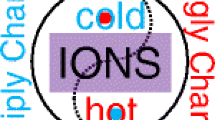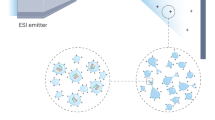Abstract
We report the development of a new AP visible-wavelength MALDI-ion trap-MS instrument with significantly improved performance over our previously reported system (Int. J. Mass Spectrom. 315, 66–73 (2012)). A Nd:YAG pulsed laser emitting light at 532 nm was used to desorb and ionize oligosaccharides and peptides in transmission geometry through a glass slide. Limits of detection (LODs) achieved in MS mode correspond to picomole quantities of oligosaccharides and femtomole quantities of peptides. Tandem MS (MS/MS) experiments enabled identification of enzymatically digested proteins and oligosaccharides by comparison of MS/MS spectra with data found in protein and glycan databases. Moreover, the softness of ionization, LODs, and fragmentation spectra of biomolecules by AP visible-wavelength MALDI-MS were compared to those obtained by AP UV MALDI-MS using a Nd:YAG laser emitting light at 355 nm. AP visible-wavelength MALDI appears to be a softer ionization technique then AP UV MALDI for the analysis of sulfated peptides, while visible-wavelength MALDI-MS, MS/MS, and MS/MS/MS spectra of other biomolecules analyzed were mostly similar to those obtained by AP UV MALDI-MS. Therefore, the methodology presented will be useful for MS and MSn analyses of biomolecules at atmospheric pressure. Additionally, the AP visible-wavelength MALDI developed can be readily used for soft ionization of analytes on various mass spectrometers.

ᅟ




Similar content being viewed by others
References
Karas, M., Hillenkamp, F.: Laser desorption ionization of proteins with molecular masses exceeding 10,000 Daltons. Anal. Chem. 60, 2299–2301 (1988)
Tanaka, K., Waki, H., Ido, Y., Akita, S., Yoshida, Y., Yoshida, T.: Protein and polymer analyses up to m/z 100 000 by laser ionization time-of-flight mass spectrometry. Rapid Commun. Mass Spectrom. 2, 151–153 (1988)
Beavis, R.C., Chaudhary, T., Chait, B.T.: Alpha-cyano-4-hydroxycinnamic acid as a matrix for matrix-assisted laser desorption mass-spectrometry. Org. Mass Spectrom. 27, 156–158 (1992)
Strupat, K., Karas, M., Hillenkamp, F.: 2,5-Dihydroxybenzoic acid—a new matrix for laser desorption ionization mass-spectrometry. Int. J. Mass Spectrom. Ion Process. 111, 89–102 (1991)
Chen, X., Carroll, J.A., Beavis, R.C.: Near-ultraviolet-induced matrix-assisted laser desorption/ionization as a function of wavelength. J. Am. Soc. Mass Spectrom. 9, 885–891 (1998)
Chen, L.C., Asakawa, D., Hori, H., Hiraoka, K.: Matrix-assisted laser desorption/ionization mass spectrometry using a visible laser. Rapid Commun. Mass Spectrom. 21, 4129–4134 (2007)
Tang, K., Allman, S.L., Jones, R.B., Chen, C.H.: Comparison of rhodamine dyes as matrices for matrix-assisted laser desorption/ionization mass spectroscopy. Org. Mass Spectrom. 27, 1389–1392 (1992)
Yang, C.Y., Hu, X.K., Loboda, A.V., Lipson, R.H.: A useful binary matrix for visible-MALDI of low molecular weight analytes. J. Am. Soc. Mass Spectrom. 21, 294–299 (2010)
Romano, L.J., Levis, R.J.: Nondestructive laser vaporization of high molecular weight, single-stranded DNA. J. Am. Chem. Soc. 113, 9665–9667 (1991)
Cornett, D.S., Duncan, M.A., Amster, I.J.: Liquid-mixtures for matrix-assisted laser-desorption. Anal. Chem. 65, 2608–2613 (1993)
Smith, C.J., Chang, S.Y., Yeung, E.S.: Characterization of neutral red as a visible-wavelength MALDI matrix. J. Mass Spectrom. 30, 1765–1767 (1995)
Hu, X.K., Lacey, D., Li, J., Yang, C., Loboda, A.V., Lipson, R.H.: Visible wavelength MALDI using coumarin laser dyes. Int. J. Mass Spectrom. 278, 69–74 (2008)
Sun, Z., Findsen, E.W., Isailovic, D.: Atmospheric pressure visible-wavelength MALDI-MS. Int. J. Mass Spectrom. 315, 66–73 (2012)
Creaser, C.S., Reynolds, J.C., Harvey, D.J.: Structural analysis of oligosaccharides by atmospheric pressure matrix-assisted laser desorption/ionisation quadrupole ion trap mass spectrometry. Rapid Commun. Mass Spectrom. 16, 176–184 (2002)
Laiko, V.V., Baldwin, M.A., Burlingame, A.L.: Atmospheric pressure matrix-assisted laser desorption/ionization mass spectromtry. Anal. Chem. 72, 652–657 (2000)
Laiko, V.V., Burlingame, A.L.: US Patent 5965884 (1999)
Tan, P.V., Laiko, V.V., Doroshenko, V.M.: Atmospheric pressure MALDI with pulsed dynamic focusing for high-efficiency transmission of ions into a mass spectrometer. Anal. Chem. 76, 2462–2469 (2004)
Miller, C.A., Yi, D., Perkins, P.D.: An atmospheric pressure matrix-assisted laser desorption/ionization ion trap with enhanced sensitivity. Rapid Commun. Mass Spectrom. 17, 860–868 (2003)
Laiko, V.V., Moyer, S.C., Cotter, R.J.: Atmospheric pressure MALDI/ion trap mass spectrometry. Anal. Chem. 72, 5239–5243 (2000)
Laiko, V.V.: Atmospheric pressure matrix-assisted laser desorption ionization. In: Gross, M.L., Caprioli, R.M. (eds.) The Encyclopedia of Mass Spectrometry, Vol. 6: Ionization Methods, pp. 695–700. Elsevier Science, Amsterdam (2007)
Schneider, B.B., Lock, C., Covey, T.R.: AP and vacuum MALDI on a QqLIT instrument. J. Am. Soc. Mass Spectrom. 16, 176–182 (2005)
Navare, A.T., Fernández, F.M.: Inline pneumatically assisted atmospheric pressure matrix-assisted laser desorption/ionization ion trap mass spectrometry. J. Mass Spectrom. 45, 635–642 (2010)
Kellersberger, K.A., Tan, P.V., Laiko, V.V., Doroshenko, V.M., Fabris, D.: Atmoshperic pressure MALDI-Fourier transform mass spectrometry. Anal. Chem. 76, 3930–3934 (2004)
Galicia, M.C., Vertes, A., Callahan, J.H.: Atmospheric pressure matrix-assisted laser desorption/ionization in transmission geometry. Anal. Chem. 74, 1891–1895 (2002)
Schürenberg, M., Schulz, T., Dreisewerd, K., Hillenkamp, F.: Matrix-assisted laser desorption/ionization in transmission geometry: instrumental implementation and mechanistic implications. Rapid Commun. Mass Spectrom. 10, 1873–1880 (1996)
Ehring, H., Costa, C., Plame, D., Sundqvist, U.R.: Photochemical versus thermal mechanisms in matrix-assisted laser desorption/ionization probed by back side desorption. Rapid Commun. Mass Spectrom. 10, 821–824 (1996)
Schürenberg, M., Schulz, T., Dreisewerd, K., Hillenkamp, F.: Matrix-assisted laser desorption/ionization in transmission geometry: instrumental implementation and mechanistic implications. Rapid Commun. Mass Spectrom. 10, 1873–1880 (1996)
Vertes, A., Balazs, L., Gijbels, R.: Matrix-assisted laser desorption of peptides in transmission geometry. Rapid Commun. Mass Spectrom. 4, 263–266 (1990)
Lennon III, J.D., Glish, G.L.: A MALDI probe for mass spectrometers. Anal. Chem. 69, 2525–2529 (1997)
Pérez, J., Petzold, C.J., Watkins, M.A., Vaughn, W.E., Kenttämaa, H.I.: Laser desorption in transmission geometry inside a Fourier-transform ion cyclotron resonance mass spectrometer. J. Am. Soc. Mass Spectrom. 10, 1105–1110 (1999)
Trimpin, S., Herath, T.N., Inutan, E.D., Cernat, S.A., Miller, J.B., Mackie, K., Walker, J.M.: Field-free transmission geometry atmospheric pressure matrix-assisted laser desorption/ionization for rapid analysis of unadulterated tissue samples. Rapid Commun. Mass Spectrom. 23, 3023–3027 (2009)
Richards, A.L., Lietz, C.B., Wager-Miller, J.B., Mackie, K., Trimpin, S.: Imaging mass spectrometry in transmission geometry. Rapid Commun. Mass Spectrom. 25, 815–820 (2011)
Zavalin, A., Todd, E.M., Rawhouser, P.D., Yang, J., Norris, J.L., Caprioli, R.M.: Direct imaging of single cells and tissue at sub-cellular spatial resolution using transmission geometry MALDI MS. J. Mass Spectrom. 47, 1473–1481 (2012)
Thiery-Lavenant, G., Zavalin, A.I., Caprioli, R.M.: Targeted multiplex imaging mass spectrometry in transmission geometry for subcellular spatial resolution. J. Am. Soc. Mass Spectrom. 24, 609–614 (2013)
Moyer, S. C., Cotter, R. J. Atmospheric pressure MALDI. Anal. Chem. 74, 469A–476A (2002)
Cramer, R., Dreisewerd, K.: UV matrix-assisted laser desorption ionization: principles, instrumentation, and applications. In: Gross, M.L., Caprioli, R.M. (eds.) The Encyclopedia of Mass Spectrometry, Vol. 6: Ionization Methods, pp. 646–661. Elsevier Science, Amsterdam (2007)
Domon, B., Costello, C.E.: A systematic nomenclature for carbohydrate fragmentations in FAB-MS/MS spectra of glycoconjugates. Glycoconj. J. 5, 397–409 (1988)
McEwen, C.N., Larsen, B.S., Trimpin, S.: Laserspray ionization on a commercial atmospheric pressure-MALDI mass spectrometer ion source: selecting singly or multiply charged ions. Anal. Chem. 82, 4998–5001 (2010)
Hillenkamp, F., Karas, M.: The MALDI process and method. In: Hillenkamp, F., Katalinic, J. (eds.) MALDI-MS: A Practical Guide to Instrumentation, Methods, and Applications, pp. 1–28. Wiley-VCH, Weinheim, Germany (2007)
Cornett, D.S., Duncan, D.A., Amster, I.J.: Matrix-assisted laser desorption at visible wavelengths using a 2-component matrix. Org. Mass Spectrom. 27, 831–832 (1992)
Acknowledgments
This work was supported by research funds from the University of Toledo (D.I.). The authors thank Walter Berger, Jr. for machining parts for the AP MALDI source, Dr. Yong Wah Kim for his help with fixing and maintaining the ion trap instrument, Dr. Ming Liu for the gift of the cholecystokinin peptide, and Technical Support from Thermo Scientific for useful advice.
Author information
Authors and Affiliations
Corresponding author
Electronic Supplementary Material
Below is the link to the electronic supplementary material.
Figure S1
AP visible-wavelength MALDI MS/MS/MS spectra of selected ions from (a) angiotensin II (m/z 931.45) and (b) [Glu]-fibrinopeptide B (m/z 1553.60) (DOC 124 kb)
Figure S2
AP visible-wavelength MALDI MS spectra of doubly charged ion of insulin (m/z 2867.62) and triply charged ion of insulin (m/z 1912.13). (DOC 111 kb)
Figure S3
AP visible-wavelength MALDI mass spectrum corresponding to the LOD of angiotensin II (19 fmol). (DOC 98 kb)
Figure S4
AP UV MALDI mass spectra of (a) raffinose (59 nmol), (b) maltoheptaose (26 nmol), (c) angiotensin II (28 nmol), and (d) [Glu]-fibrinopeptide B (19 nmol) acquired in positive ion mode. DHB and 2-amino-3-nitrophenol were used as the matrices for the analysis of oligosaccharides and peptides, respectively. (DOC 132 kb)
Figure S5
AP UV MALDI MS/MS spectra of (a) raffinose (m/z 527.13), (b) maltoheptaose (m/z 1175.47), (c) angiotensin II (m/z 1046.60), and (d) [Glu]-fibrinopeptide B (m/z 1571.87). (DOC 163 kb)
Figure S6
AP UV MALDI MS/MS/MS spectra of selected ions from (a) angiotensin II (m/z 931.53) and (b) [Glu]-fibrinopeptide B (m/z 1552.67). (DOC 139 kb)
Figure S7
AP UV MALDI mass spectrum corresponding to the LOD of angiotensin II (190 amol). (DOC 97 kb)
Figure S8
AP UV MALDI mass spectrum of 3 pmol BSA tryptic digest. (DOC 92 kb)
Figure S9
AP visible-wavelength MALDI mass spectrum of cholecystokinin amide fragment 26–33 (2.6 nmol) obtained in negative ion mode. This spectrum shows the deprotonated ion (m/z 1141.60) and minimal amounts of desulfated (m/z 1061.20) ion due to fragmentation. (DOC 74 kb)
Rights and permissions
About this article
Cite this article
West, R.E., Findsen, E.W. & Isailovic, D. Analysis of Biomolecules by Atmospheric Pressure Visible-Wavelength MALDI-Ion Trap-MS in Transmission Geometry. J. Am. Soc. Mass Spectrom. 24, 1467–1476 (2013). https://doi.org/10.1007/s13361-013-0691-0
Received:
Revised:
Accepted:
Published:
Issue Date:
DOI: https://doi.org/10.1007/s13361-013-0691-0




